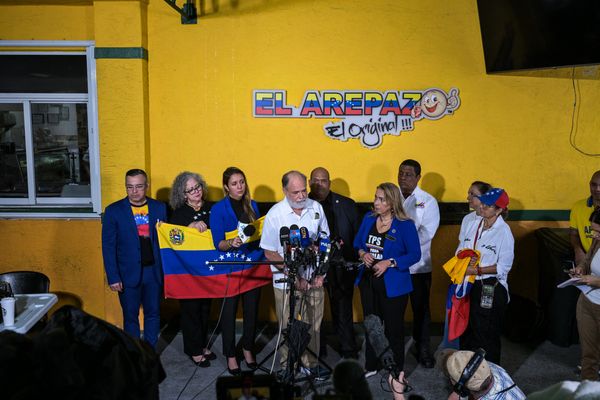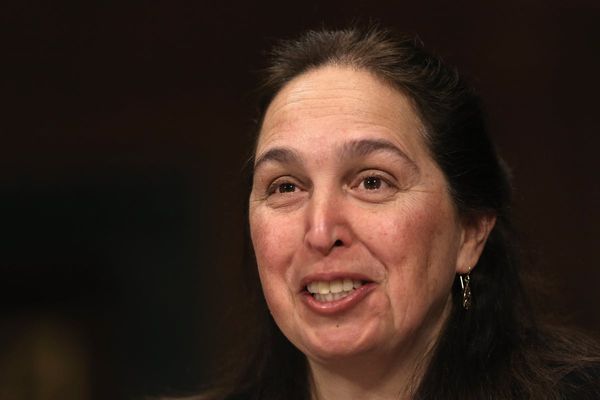/https://static.texastribune.org/media/files/79de5d5714a19a228f1824435e94b572/Farmer%20PFAS%20AS%20TT%2040.jpg)
JOHNSON COUNTY — Tony Coleman recognizes the signs all too well. A cow drools strings of saliva. Then it starts to limp, each step slower. Then it grows stiff.
Then it’s quick. There’s nothing to be done. The cow dies.
Since early 2023, the Grandview rancher has watched more than 35 of his 150 Black Angus cattle perish. July was especially brutal. In the span of a week, Coleman lost a 3-week-old calf; a cow; and Little Red, a strong bull full of spirit, leaving Coleman with nothing but unanswered questions.
“This is destroying our lives,” Coleman said. “You never know what you're going to get every day when you get down here.”
Next door, James Farmer has lost two calves, and found two of his wife’s beloved horses toppled to the ground like dominos, their bodies swarmed by buzzards.
“It's hard for me to tell her, because I know she's gonna break down,” he said. “Why are our animals dying? Just back to back? It never ends.”
Months before, the men said they noticed a gag-inducing sewage smell drifting from smoking piles of fertilizer on their neighbor’s property. Heavy rains then washed some of the fertilizer onto their land. Soon after, they said they found fish floating dead in the stock ponds their livestock drink from.
/https://static.texastribune.org/media/files/63b48288455b7441bda2e6e3f1b61385/Rancher%20Collage%20TT%2001.jpg)
They contacted the county with their concerns, triggering a nine-month investigation. That’s when their cattle and horses began to die.
An environmental crime investigator in Johnson County collected samples of the dead animals’ tissue and organs, the water they drank from, the soil and the fertilizer that was applied next door.
After the county received test results, the two families finally got their answer: The animals had been killed by something in the fertilizer.
The fertilizer had been made with biosolids, part of an effort to find a climate-friendly method to recycle municipal sewage. But the fertilizer also contained synthetic and highly hazardous chemicals known as PFAS, which are found in hundreds of household products and have had devastating effects on farms and ranches that inadvertently spread them on their land.
An untold number of farms and ranches across Texas and the rest of the nation may have also used fertilizer made from sewage tainted with these “forever chemicals” — which don’t break down in the environment — without knowing it.
PFAS, or perfluoroalkyl and polyfluoroalkyl substances, are man-made chemicals used since the 1940s that have a singular ability to repel oil and water and resist heat. They are used in products like nonstick cookware, pizza boxes, waterproof mascara, toilet paper, soaps and rain jackets.
There are more than 12,000 types of PFAS, but researchers have only studied the health effects of roughly 150. They can contaminate food and water and build up in the body over time. Exposure to certain PFAS has been linked to cancer, low birth rates and birth defects, damage to the liver and immune system, and other serious health problems. One study found the chemicals in the blood of nearly 97% of all Americans.
Due to their widespread use in consumer products, forever chemicals have been discharged into waterways by chemical manufacturers, trucked to landfills with household trash or flushed into city sewers via toilets, sinks, showers and washing machines.
Then they end up in local wastewater treatment plants where the solids are separated from sewage. Fertilizer companies who are often paid to haul these biosolids away process them into fertilizer that’s sold to farmers and ranchers as a cheaper alternative to chemical fertilizers.
A number of Texas wastewater plants have contracts with fertilizer companies to take their biosolids, including Fort Worth, Houston, San Antonio, Dallas and Arlington. Nationally, more than half of sewage sludge was treated and spread on land, according to one study; 19 billion pounds of it was spread on American farms between 2016 and 2021, the nonprofit Environmental Working Group found in 2022.
Wastewater treatment and biosolids experts call this an environmental win-win because those solids don’t go to landfills or incinerators — processes that create greenhouse gasses, which contribute to climate change.
But nobody knows how much of that fertilizer is contaminated with PFAS, which can be absorbed by crops, consumed by livestock, and then enter the food supply. There are no requirements to test biosolids for PFAS, or to warn farmers and ranchers that they could be using contaminated fertilizer made with biosolids on their land.
“Some people are saying, [PFAS contamination] are isolated incidents. No, they're not. I guarantee that this is a problem in every single state that uses biosolids,” said Kyla Bennett, a former U.S. Environmental Protection Agency employee who is now a science policy director for the nonprofit group Public Employees for Environmental Responsibility.
“The reason we're not hearing about it all over the country, in all 50 states, is because nobody's looking for this problem,” Bennett added.
According to EPA data analyzed by the nonprofit Environmental Working Group in 2022, an estimated 5% of all crop fields in the U.S. — up to 20 million acres — could have used fertilizer made with biosolids. In Texas, more than 157,000 dry metric tons of biosolids-based fertilizer were applied to agricultural lands in 2018.
While the EPA recently set limits for a handful of the chemicals in drinking water, those rules do not cover biosolids.
“The evidence is out there” that PFAS are a health hazard, Bennett said. “We shouldn’t have to wait [for the EPA to act].”
Without federal regulations, some states have taken action, requiring wastewater treatment plants to test their biosolids for PFAS or setting their own limits for PFAS in biosolids. Texas is not among them. State environmental regulators said in a statement they’re not required to by law.
/https://static.texastribune.org/media/files/a97d6e6fd014bd6ee2e0cab002d0038f/Colemans%20and%20Ranch%20AS%20TT%2001.jpg)
Coleman and other Johnson County farmers who know their land is contaminated are now faced with an existential dilemma: Do they sell their cattle and their crops, knowing they’re likely laced with PFAS, or face financial ruin?
Coleman and Farmer have both decided not to sell any cattle. That means the men now run zombie farms. They pay to feed animals and harvest hay that they won’t sell — a single 900-pound steer could sell for $4,800, Coleman said.
“Everything we plant here is just sucking this [PFAS] stuff up,” Coleman said. “The cows drink the water and eat the grass. For them there is no escaping.”
Anxiety in Johnson County
/https://static.texastribune.org/media/files/a8f573082bd196d573104c4b3ebd76e1/Farmer%20PFAS%20AS%20TT%2008.jpg)
In February, Johnson County residents packed the courthouse and listened intently as Dana Ames, an environmental crime investigator for the county, and other local officials explained the findings from the nine-month investigation into the noxious smells and dead livestock.
Ames, who spent $35,000 of the county’s money on the investigation and sent samples to a lab in Pennsylvania, told residents that the liver of the Coleman’s stillborn calf contained 610,000 parts per trillion of perfluorooctane sulfonic acid, or PFOS, one of the many types of forever chemicals.
The tissue from a calf belonging to Farmer that died a week after being born tested at 320 ppt of PFOS.
Currently, there are no federal food safety standards for PFAS. In Maine, which in 2016 became the first state to detect PFAS contamination at a farm, state officials issued limits for beef containing PFOS at 3.4 parts per billion and milk containing PFOS at 210 parts per trillion — meaning that beef or milk exceeding these levels should be considered unsafe for consumption. Maine, which has discovered 78 contaminated farms and shut five of them down, has been the only state to set its own PFAS limits for food.
Samples of the pond water where the ranching families’ livestock drink from ranged from 84 ppt to 1,333 ppt of PFAS.
The county also tested the fertilizer their neighbor spread on his farm and found 27 types of PFAS chemicals, including four out of the five the EPA has set limits for in drinking water.
/https://static.texastribune.org/media/files/2e9efa08fa77deab76b280f3a74d7239/Farmer%20PFAS%20AS%20TT%2029.jpg)
“These people were led to believe this was safe and a cheap fertilizer,” County Commissioner Larry Woolley said at the meeting. “And this isn’t just isolated to this one incident or multiple counties. This is going on all over.”
“The amount of beef and milk that’s gone into the food chain, who knows what their PFAS levels are? The level of victimization is widespread,” he added.
The Colemans, Farmer and four other local farmers have sued Synagro, the Maryland-based company that produced the biosolids-based fertilizer applied on their neighbor’s fields, and Renda Environmental, a Texas-based fertilizer company that sold to the neighbor before Synagro. The lawsuit claims the companies knew about the contaminants in the fertilizer and failed to provide adequate warnings to its customers.
Synagro denies the allegations. Kip Cleverley, a spokesperson with the company, said the company did its own testing on the land where the fertilizer was applied and preliminary results found PFAS levels in the single digits parts per trillion in the surface water. The company did not provide its test results to the Tribune, saying its analysis was still in progress.
“The data strongly suggests that the farm where biosolids were used could not be a source for the PFAS allegedly found on the plaintiffs’ farms,” Cleverley said.
Renda Environmental told the Tribune the company does not comment on pending litigation.
In a separate lawsuit filed against the EPA in June by Public Employees for Environmental Responsibility on behalf of the farmers, the group claimed the agency failed to implement restrictions on PFAS in biosolids despite knowing the health risks posed by the chemicals. Johnson County later joined the suit.
“My heart breaks [for the farmers],” said Bennett, the group's science policy director. “It could be years until the EPA sets biosolids regulations. Somebody needs to hold their feet to the fire … farmers are losing their livelihoods.”
The biosolids used to create the fertilizer that allegedly contaminated the Colemans’ and Farmers’ farms came from Fort Worth’s Village Creek Water Reclamation Facility, which treats sewage from 1 million people, many industries and 23 communities in North Texas. It generates between 27,000 to 31,000 tons of biosolids per year.
/https://static.texastribune.org/media/files/45d4d67099e72516645d2258d8f373ff/Village%20Creek%20ENS%20TT%2001.jpg)
Mary Gugliuzza, spokesperson for Fort Worth Water, said the fertilizer pellets produced by Synagro meet EPA and Texas Commission on Environmental Quality requirements.
Gugliuzza added the city had tested some of its biosolids for PFAS even though it’s not required. Those results showed PFAS in the biosolids, but Gugliuzza said that’s the case at wastewater facilities across the country.
Synagro has contracts with more than 1,000 municipal wastewater plants, industrial, and agricultural customers in North America — including Fort Worth — to turn biosolids, which one employee described as resembling chocolate milk, into fertilizer that it markets as nutrient rich and environmentally friendly.
In 2022 Synagro processed 6.5 million tons of biosolids nationwide.
“The [EPA] has not suggested that any changes in biosolids management is required because of the presence of trace amounts of PFAS,” Cleverly, the company spokesperson, said.
In September, the EPA responded to the lawsuit saying it has complete discretion over which pollutants to regulate under federal law — so it can't be sued.
But the agency is now studying the presence of PFAS in wastewater and sewage sludge nationally and conducting a risk assessment on the use of biosolids and sewage sludge containing the two most widely used and studied forever chemicals — PFOA and PFOS — focusing on health risks through exposure to soil, water, crops, meat and dairy. It expects to publish the results by the end of this year, which will determine whether new federal rules are necessary.
Who should be responsible for removing forever chemicals?
/https://static.texastribune.org/media/files/e0c16659eb94e872169745ed78c88cc6/SA%20Water%20Treatment%20CS%20TT%2012.jpg)
In Texas, most biosolids end up in a landfill. But the rest is diverted for agricultural use in Texas.
At San Antonio’s wastewater treatment plant, water is removed from sewage sludge by using a machine that squeezes it between two tensioned belts or by spreading it in drying beds so the sun evaporates the moisture. Once it’s dried to a crumb-like texture, the biosolids are piled into black mountains then transported to other facilities where two Texas compost companies turn it into fertilizer.
Pitched as a cost-effective way to improve soil fertility, biosolids have been applied to land in the U.S. since the 1970s. Scientists say they contain nitrogen, phosphorus and potassium that helps plants grow.
The EPA only requires wastewater treatment plants to test biosolids for heavy metals and pathogens that can be harmful to health.
/https://static.texastribune.org/media/files/9278cd062732954927704ee5a24a3f6d/Wastewater%20Process%20CS%20TT%2001.jpg)
If the EPA issues new restrictions on PFAS in biosolids, utilities fear they are likely to bear the responsibility for removing the chemicals from wastewater.
“If we are required to treat a particular chemical that is not covered in the way you already treat, you have to design a whole new system,” said Ed Guzman, the senior vice president and chief legal and ethics officer at the San Antonio Water System. “You have to put it in place and that all takes time. It takes money.”
The cost of removal is significant: A 2023 report by the Minnesota Pollution Control Agency found that it would cost between $2.7 million and $18 million per pound to remove and destroy PFAS from municipal wastewater, depending on facility size, and between $1 million and $2.7 million per pound of PFAS removed from biosolids.
Adam Krantz, the CEO of the National Association of Clean Water Agencies, a group representing municipal wastewater treatment agencies, said the cost of remediation could be passed down to water utility customers, but argues that "polluters should pay."“It really is the corporate polluter that needs to foot the bill for this as the wrongdoer,” he said.
Others, like Janine Burke-Wells, executive director for the North East Biosolids & Residuals Association, which represents wastewater treatment facilities and biosolids producers, said that the responsibility to curb PFAS should fall on everyone.
“Unless we really eliminate all the sources of PFAS there's always going to be a background level because [PFAS] is in everything,” Burke-Wells said.
One county doing what it can
/https://static.texastribune.org/media/files/b433bb854835217505215dba285308c9/Farmer%20PFAS%20AS%20TT%2014.jpg)
In Johnson County, Woolley drives his silver pickup down rural roads, pointing out hay bales and miles of milo grain, corn and wheat — crops the county commissioner says have been blessed by heavy rainfall earlier this year.
Woolley, a former agriculture teacher who moved to Grandivew in 1982, says he’s spent sleepless nights worrying about PFAS’ impacts on ranching families in this county of 180,000 residents.
“I lay awake at night thinking of the magnitude of this whole deal. It’s just crazy,” Woolley said. “This is just the tip of the iceberg. I think there's gonna be so much public outcry on this … it's gonna be hard for our state officials to ignore that.”
Following the county’s investigation, Woolley led the charge to pass a local resolution urging farmers to stop using biosolids on their land.
The resolution called for Fort Worth to stop sending its biosolids to fertilizer companies until the TCEQ tests them for the presence of PFAS and asked the EPA to set limits on PFAS in biosolids. The resolution also called on state lawmakers to regulate the application of biosolids-based fertilizer on farmland or give power to counties to do so.
“That’s the hard part,” Woolley said. “We don’t have authority to ban biosolids.”
In July, neighboring Ellis County passed a similar resolution calling for regulation and legislation to restrict the application of biosolids on farms and ranches until further testing is done. Since then, Kaufman, Henderson, Somervell and Wise counties have done the same.
Woolley has traveled around the state to sound the alarm about PFAS at conferences for county officials. He said he and his staff are preparing to go to Austin to meet with state lawmakers during the next legislative session. He hopes they will introduce new bills that will address PFAS contamination in biosolids, including giving counties money to test for the contaminants, and require TCEQ to test biosolids statewide for forever chemicals.
So far, there have been no bills filed by state lawmakers regarding PFAS contamination in biosolids ahead of the legislative session that begins in January.
In 2021, Michigan began requiring all municipal wastewater treatment plants to test their biosolids for PFAS before spreading them on agricultural land. The state also began prohibiting the application of biosolids containing more than 150 parts per billion of PFOS on agricultural land. Since then, the state has lowered that threshold to 100 ppb and added another type of PFAS to the list, PFOA.
What experts refer to as the "Michigan model" has now been embraced by other states including California, Wisconsin and Washington. Connecticut and Maine have banned the use of biosolids on agricultural fields.
Ellen Mallory, a professor of sustainable agriculture at The University of Maine, said state response has been crucial given the lack of standards at the federal level.
“The important part here is it's really hard to have any response to PFAS contamination if we don't have any standards. So a state like Texas that has no standards, what do you do? How do you help farmers determine if their food is safe or not?” she said.
Meanwhile, Tony Coleman and his wife are still watching their livestock die. They pack dead cattle in a big cooler, load them onto a trailer and drive 140 miles to a laboratory at College Station where vet technicians perform a necropsy and remove tissue to be tested for PFAS.
The couple both work two jobs and are looking for a third. They're worried they have lost the ability to make a living off their own land.
“We can't consciously sell you a side of beef and then you eat it and you get sick. What kind of people does that make us?” Coleman said.
Disclosure: San Antonio Water System has been a financial supporter of The Texas Tribune, a nonprofit, nonpartisan news organization that is funded in part by donations from members, foundations and corporate sponsors. Financial supporters play no role in the Tribune's journalism. Find a complete list of them here.
/https://static.texastribune.org/media/files/edca26a68f1f7f0c9bd954e7458e73db/Farmer%20PFAS%20AS%20TT%2039.jpg)







